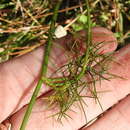Comprehensive Description
(
İngilizce
)
North American Flora tarafından sağlandı
Ptilimnium costatum (Ell.) Raf. Bull. Bot. Seringe 217. 1830
Ammi costatum Ell. Bot. S. C. & Ga. 1: 350. 1817.
Discopleura capillacea var. costata DC. Coll. Mem. 5: 39. 1829.
Discopleura costata Steud. Nom. Bot. ed. 2. 1: 520. 1840.
Ptilimnium missouriense Coult. & Rose, Contr. U. S. Nat. Herb. 12: 444. 1909.
Plants S-15 dm. high; leaves oblong in general outline, excluding the petioles 4.5-14 cm. long, 2-7 cm. broad, pinnately decompound, the ultimate divisions filiform, acute, 3-8 mm. long, 0.2-1 mm. broad, crowded, appearing verticillate; petioles 0.5-3 cm. long, entirely sheathing, unwinged; peduncles 7-14 cm. long, exceeding the leaves; involucre of very short, usually entire bracts; involucel' of entire bractlets shorter than the pedicels; rays about 20, spreading, subequal, 1.5-4 cm. long; pedicels 15-20, spreading, 4—5 mm. long; petals acuminate; calyxteeth conspicuous, deltoid, acute to subacuminate, persistent; styles elongate, usually more than twice the length of the conic stylopodium; anthers rose-colored; fruit ovoid, 2-4 mm. long, 2—3 mm. broad.
Type locality: "Swamps along the margin of the Ogeechee River, Mount Prosper," Elliott? Distribution: North Carolina and Georgia, west to Missouri and Texas (Harper 770, Palmer 8989).
- bibliyografik atıf
- Albert Charles Smith, Mildred Esther Mathias, Lincoln Constance, Harold William Rickett. 1944-1945. UMBELLALES and CORNALES. North American flora. vol 28B. New York Botanical Garden, New York, NY
Ptilimnium costatum
(
İngilizce
)
wikipedia EN tarafından sağlandı
Ptilimnium costatum, commonly called big bishopweed,[1] is a species of flowering plant in the carrot family (Apiaceae). It is native to the southeastern United States. It has a scattered and disjunct distribution, and is rare throughout its range.[1] Its natural habitat in wetlands, such as swamps, marshes, and wet prairies.[1][2]
Ptilimnium costatum is a robust perennial, growing to 150 cm tall. It produces umbels of small white flowers. It flowers and fruits from June to October, which is generally later in the season that other Ptilimnium in its range. In addition, it can be distinguished from other nearby Ptilimnium by its longer fruit styles (1–2 mm) and perennial habit from a corm base.[1]
Populations that were previously considered Ptilimnium costatum in the West Gulf Coastal Plain of Arkansas, Louisiana, and Texas, have been treated as Ptilimnium texense as of 2010. This reinstatement was based on combination of molecular, morphological, and ecological evidence.[3]
References
-
^ a b c d Weakley, Alan (2015). "Flora of the Southern and Mid-Atlantic States".
-
^ Yatskievych, George (2006). Flora of Missouri, Volume 2. Missouri Botanical Garden Press. p. 99.
-
^ Feist, Mary (2010). "The reinstatement of Ptilimnium texense (Apiaceae) and a new key to the genus". Journal of the Botanical Research Institute of Texas. 4 (2): 641–651. JSTOR 41972087.

- lisans
- cc-by-sa-3.0
- telif hakkı
- Wikipedia authors and editors
Ptilimnium costatum: Brief Summary
(
İngilizce
)
wikipedia EN tarafından sağlandı
Ptilimnium costatum, commonly called big bishopweed, is a species of flowering plant in the carrot family (Apiaceae). It is native to the southeastern United States. It has a scattered and disjunct distribution, and is rare throughout its range. Its natural habitat in wetlands, such as swamps, marshes, and wet prairies.
Ptilimnium costatum is a robust perennial, growing to 150 cm tall. It produces umbels of small white flowers. It flowers and fruits from June to October, which is generally later in the season that other Ptilimnium in its range. In addition, it can be distinguished from other nearby Ptilimnium by its longer fruit styles (1–2 mm) and perennial habit from a corm base.
Populations that were previously considered Ptilimnium costatum in the West Gulf Coastal Plain of Arkansas, Louisiana, and Texas, have been treated as Ptilimnium texense as of 2010. This reinstatement was based on combination of molecular, morphological, and ecological evidence.
- lisans
- cc-by-sa-3.0
- telif hakkı
- Wikipedia authors and editors

